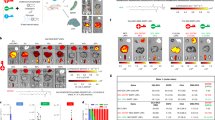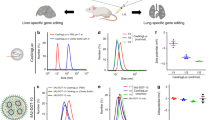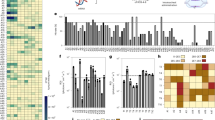Abstract
Systemically delivered lipid nanoparticles are preferentially taken up by hepatocytes. This hinders the development of effective, non-viral means of editing genes in tissues other than the liver. Here we show that lipid-nanoparticle-mediated gene editing in the lung and spleen of adult mice can be enhanced by reducing Cas9-mediated insertions and deletions in hepatocytes via oligonucleotides disrupting the secondary structure of single-guide RNAs (sgRNAs) and also via their combination with short interfering RNA (siRNA) targeting Cas9 messenger RNA (mRNA). In SpCas9 mice with acute lung inflammation, the systemic delivery of an oligonucleotide inhibiting an sgRNA targeting the intercellular adhesion molecule 2 (ICAM-2), followed by the delivery of the sgRNA, reduced the fraction of ICAM-2 indels in hepatocytes and increased that in lung endothelial cells. In wild-type mice, the lipid-nanoparticle-mediated delivery of an inhibitory oligonucleotide, followed by the delivery of Cas9-degrading siRNA and then by Cas9 mRNA and sgRNA, reduced the fraction of ICAM-2 indels in hepatocytes but not in splenic endothelial cells. Inhibitory oligonucleotides and siRNAs could be used to modulate the cell-type specificity of Cas9 therapies.
This is a preview of subscription content, access via your institution
Access options
Access Nature and 54 other Nature Portfolio journals
Get Nature+, our best-value online-access subscription
$29.99 / 30 days
cancel any time
Subscribe to this journal
Receive 12 digital issues and online access to articles
$99.00 per year
only $8.25 per issue
Buy this article
- Purchase on Springer Link
- Instant access to full article PDF
Prices may be subject to local taxes which are calculated during checkout






Similar content being viewed by others
Data availability
The main data supporting the results in this study are available within the paper and its Supplementary Information. The raw and analysed datasets generated during the study are too large to be publicly shared, but they are available for research purposes from the corresponding author on reasonable request.
References
Gillmore, J. D. et al. CRISPR–Cas9 in vivo gene editing for transthyretin amyloidosis. N. Engl. J. Med. 385, 493–502 (2021).
Porteus, M. H. A new class of medicines through DNA editing. N. Engl. J. Med. 380, 947–959 (2019).
Paunovska, K., Loughrey, D. & Dahlman, J. E. Drug delivery systems for RNA therapeutics. Nat. Rev. Genet. https://doi.org/10.1038/s41576-021-00439-4 (2022).
Lee, B. et al. Nanoparticle delivery of CRISPR into the brain rescues a mouse model of fragile X syndrome from exaggerated repetitive behaviours. Nat. Biomed. Eng. 2, 497–507 (2018).
Lee, K. et al. Nanoparticle delivery of Cas9 ribonucleoprotein and donor DNA in vivo induces homology-directed DNA repair. Nat. Biomed. Eng. 1, 889–901 (2017).
Gao, X. et al. Treatment of autosomal dominant hearing loss by in vivo delivery of genome editing agents. Nature 553, 217–221 (2018).
Miller, J. B. et al. Non-viral CRISPR/Cas gene editing in vitro and in vivo enabled by synthetic nanoparticle co-delivery of Cas9 mRNA and sgRNA. Angew. Chem. Int. Ed. 56, 1059–1063 (2017).
Jiang, C. et al. A non-viral CRISPR/Cas9 delivery system for therapeutically targeting HBV DNA and pcsk9 in vivo. Cell Res. 27, 440–443 (2017).
Yin, H. et al. Structure-guided chemical modification of guide RNA enables potent non-viral in vivo genome editing. Nat. Biotechnol. 35, 1179–1187 (2017).
Finn, J. D. et al. A single administration of CRISPR/Cas9 lipid nanoparticles achieves robust and persistent in vivo genome editing. Cell Rep. 22, 2227–2235 (2018).
Rothgangl, T. et al. In vivo adenine base editing of PCSK9 in macaques reduces LDL cholesterol levels. Nat. Biotechnol. 39, 949–957 (2021).
Musunuru, K. et al. In vivo CRISPR base editing of PCSK9 durably lowers cholesterol in primates. Nature 593, 429–434 (2021).
Zhang, X. et al. Functionalized lipid-like nanoparticles for in vivo mRNA delivery and base editing. Sci. Adv. 6, eabc2315 (2020).
Lorenzer, C., Dirin, M., Winkler, A. M., Baumann, V. & Winkler, J. Going beyond the liver: progress and challenges of targeted delivery of siRNA therapeutics. J. Control. Release 203, 1–15 (2015).
Semple, S. C. et al. Rational design of cationic lipids for siRNA delivery. Nat. Biotechnol. 28, 172–176 (2010).
Dong, Y. et al. Lipopeptide nanoparticles for potent and selective siRNA delivery in rodents and nonhuman primates. Proc. Natl Acad. Sci. USA 111, 3955–3960 (2014).
Love, K. T. et al. Lipid-like materials for low-dose, in vivo gene silencing. Proc. Natl Acad. Sci. USA 107, 1864–1869 (2010).
Blanco, E., Shen, H. & Ferrari, M. Principles of nanoparticle design for overcoming biological barriers to drug delivery. Nat. Biotechnol. 33, 941–951 (2015).
Liu, S. et al. Membrane-destabilizing ionizable phospholipids for organ-selective mRNA delivery and CRISPR–Cas gene editing. Nat. Mater. 20, 701–710 (2021).
Cheng, Q. et al. Selective organ targeting (SORT) nanoparticles for tissue-specific mRNA delivery and CRISPR–Cas gene editing. Nat. Nanotechnol. 15, 313–320 (2020).
Tsoi, K. M. et al. Mechanism of hard-nanomaterial clearance by the liver. Nat. Mater. 15, 1212–1221 (2016).
Zlatev, I. et al. Reversal of siRNA-mediated gene silencing in vivo. Nat. Biotechnol. 36, 509–511 (2018).
Landgraf, P. et al. A mammalian microRNA expression atlas based on small RNA library sequencing. Cell 129, 1401–1414 (2007).
Lee, J. et al. Tissue-restricted genome editing in vivo specified by microRNA-repressible anti-CRISPR proteins. RNA 25, 1421–1431 (2019).
Pawluk, A. et al. Naturally occurring off-switches for CRISPR–Cas9. Cell 167, 1829–1838.e1829 (2016).
Shin, J. et al. Disabling Cas9 by an anti-CRISPR DNA mimic. Sci. Adv. 3, e1701620 (2017).
Zhu, Y., Zhang, F. & Huang, Z. Structural insights into the inactivation of CRISPR–Cas systems by diverse anti-CRISPR proteins. BMC Biol.16, 32 (2018).
Maji, B. et al. A high-throughput platform to identify small-molecule inhibitors of CRISPR–Cas9. Cell 177, 1067–1079.e1019. (2019).
Levin, A. A. Treating disease at the RNA level with oligonucleotides. N. Engl. J. Med. 380, 57–70 (2019).
Balwani, M. et al. Phase 3 trial of RNAi therapeutic givosiran for acute intermittent porphyria. N. Engl. J. Med. 382, 2289–2301 (2020).
Garrelfs, S. LB002ILLUMINATE-A, a phase 3 study of lumasiran, an investigational RNAi therapeutic, in children and adults with primary hyperoxaluria type 1 (PH1). Nephrol. Dial. Transplant. 35, gfaa146.LB002 (2020).
Deleavey, G. F. & Damha, M. J. Designing chemically modified oligonucleotides for targeted gene silencing. Chem. Biol. 19, 937–954 (2012).
Novobrantseva, T. I. et al. Systemic RNAi-mediated gene silencing in nonhuman primate and rodent myeloid cells. Mol. Ther. Nucleic Acids 1, e4 (2012).
Khan, O. F. et al. Endothelial siRNA delivery in nonhuman primates using ionizable low-molecular weight polymeric nanoparticles. Sci. Adv. 4, eaar8409 (2018).
Jinek, M. et al. A programmable dual-RNA-guided DNA endonuclease in adaptive bacterial immunity. Science 337, 816–821 (2012).
Yildirim, I., Kierzek, E., Kierzek, R. & Schatz, G. C. Interplay of LNA and 2′-O-methyl RNA in the structure and thermodynamics of RNA hybrid systems: a molecular dynamics study using the revised AMBER force field and comparison with experimental results. J. Phys. Chem. B 118, 14177–14187 (2014).
Ni, C. W., Kumar, S., Ankeny, C. J. & Jo, H. Development of immortalized mouse aortic endothelial cell lines. Vasc. Cell 6, 7 (2014).
Sago, C. D. et al. High-throughput in vivo screen of functional mRNA delivery identifies nanoparticles for endothelial cell gene editing. Proc. Natl Acad. Sci. USA 115, E9944–E9952 (2018).
Brinkman, E. K., Chen, T., Amendola, M. & van Steensel, B. Easy quantitative assessment of genome editing by sequence trace decomposition. Nucleic Acids Res. 42, e168 (2014).
Raper, A. T., Stephenson, A. A. & Suo, Z. Functional insights revealed by the kinetic mechanism of CRISPR/Cas9. J. Am. Chem. Soc. 140, 2971–2984 (2018).
Green, A. A., Silver, P. A., Collins, J. J. & Yin, P. Toehold switches: de-novo-designed regulators of gene expression. Cell 159, 925–939 (2014).
Zetsche, B. et al. Cpf1 is a single RNA-guided endonuclease of a class 2 CRISPR–Cas system. Cell 163, 759–771 (2015).
Li, B. et al. Engineering CRISPR–Cpf1 crRNAs and mRNAs to maximize genome editing efficiency. Nat. Biomed. Eng. 1, 0066 (2017).
Zhong, G., Wang, H., Li, Y., Tran, M. H. & Farzan, M. Cpf1 proteins excise CRISPR RNAs from mRNA transcripts in mammalian cells. Nat. Chem. Biol. 13, 839–841 (2017).
Li, B. et al. Synthetic oligonucleotides inhibit CRISPR-Cpf1-mediated genome editing. Cell Rep. 25, 3262–3272.e3 (2018).
Shen, X. & Corey, D. R. Chemistry, mechanism and clinical status of antisense oligonucleotides and duplex RNAs. Nucleic Acids Res. 46, 1584–1600 (2018).
Chen, D. et al. Rapid discovery of potent siRNA-containing lipid nanoparticles enabled by controlled microfluidic formulation. J. Am. Chem. Soc. 134, 6948–6951 (2012).
Cullis, P. R. & Hope, M. J. Lipid nanoparticle systems for enabling gene therapies. Mol. Ther. 25, 1467–1475 (2017).
Platt, R. J. et al. CRISPR–Cas9 knockin mice for genome editing and cancer modeling. Cell 159, 440–455 (2014).
Dahlman, J. E. et al. In vivo endothelial siRNA delivery using polymeric nanoparticles with low molecular weight. Nat. Nanotechnol. 9, 648–655 (2014).
Xue, W. et al. Small RNA combination therapy for lung cancer. Proc. Natl Acad. Sci. USA 111, E3553–E3561 (2014).
Bartlett, D. W. & Davis, M. E. Insights into the kinetics of siRNA-mediated gene silencing from live-cell and live-animal bioluminescent imaging. Nucleic Acids Res. 34, 322–333 (2006).
Hickerson, R. P. et al. Stability study of unmodified siRNA and relevance to clinical use. Oligonucleotides 18, 345–354 (2008).
Ray, K. K. et al. Inclisiran in patients at high cardiovascular risk with elevated LDL cholesterol. N. Engl. J. Med. 376, 1430–1440 (2017).
Sanhueza, C. A. et al. Efficient liver targeting by polyvalent display of a compact ligand for the asialoglycoprotein receptor. J. Am. Chem. Soc. 139, 3528–3536 (2017).
Sehgal, A. et al. An RNAi therapeutic targeting antithrombin to rebalance the coagulation system and promote hemostasis in hemophilia. Nat. Med. 21, 492–497 (2015).
Gerwin, N. et al. Prolonged eosinophil accumulation in allergic lung interstitium of ICAM-2 deficient mice results in extended hyperresponsiveness. Immunity 10, 9–19 (1999).
Ganzalo, J. A. et al. Mouse eotaxin expression parallels eosinophil accumulation during lung allergic inflammation but it is not restricted to a Th2-type response. Immunity 4, 1–14 (1996).
Alterman, J. F. et al. A divalent siRNA chemical scaffold for potent and sustained modulation of gene expression throughout the central nervous system. Nat. Biotechnol. 37, 884–894 (2019).
Brown, J. M. et al. Ligand conjugated multimeric siRNAs enable enhanced uptake and multiplexed gene silencing. Nucleic Acid Ther. 29, 239–244 (2019).
Kishimoto, T. K. et al. Improving the efficacy and safety of biologic drugs with tolerogenic nanoparticles. Nat. Nanotechnol. 11, 890–899 (2016).
Barros, S. A. & Gollob, J. A. Safety profile of RNAi nanomedicines. Adv. Drug Deliv. Rev. 64, 1730–1737 (2012).
Acknowledgements
We thank J. E. Cattie at Emory University and T. E. Shaw.
Author information
Authors and Affiliations
Contributions
C.D.S. and J.E.D. conceived the experiments. C.D.S., P.J.S., M.G.F. and J.E.D. designed the experiments. C.D.S., M.P.L., D.L., K.E.L., R.H., B.R.K., S.K., M.S., E.S.E., J.P.F., Z.G., L.G., K.P., C.A.S. and J.E.D. performed the experiments. C.D.S. and J.E.D. wrote the initial draft of the paper, which was edited by all authors.
Corresponding author
Ethics declarations
Competing interests
Patents describing the system documented in this Article have been filed with the US Patent Office. C.D.S. and J.E.D. are listed as inventors on patent (International publication no. WO2021021636A1). C.D.S. works at Beam Therapeutics. J.E.D. consults for GV. All other authors declare no competing interests.
Peer review
Peer review information
Nature Biomedical Engineering thanks Krishanu Saha and the other, anonymous, reviewer(s) for their contribution to the peer review of this work. Peer reviewer reports are available.
Additional information
Publisher’s note Springer Nature remains neutral with regard to jurisdictional claims in published maps and institutional affiliations.
Extended data
Extended Data Fig. 1 iOligo variants also inhibit Cas12a-mediated gene editing.
(a,b) Sequence and chemical modifications for crGFP and (b) previously reported full-length 41 nucleotide antisense sequence targeting Cas12a. (c) The 41 nucleotide sequence Cas12a reduced indel formation at doses of 150 nM and 50 nM when delivered to cells before crGFP and Cas12a mRNA transfection. (d) Schematic of the proposed toehold mechanism for iOligo targeting Cas12a. The iOligo Cas12a is designed to complement to full- length crGFP RNA, providing the 5’ toe-hold and disrupting RNA secondary structure. (e) The sequences of the truncated iOligo Cas12a, and proposed binding to complementary regions on crGFP. The linear region of the crRNA is required to mediate a strand displacement reaction and facilitate iOligo binding. (F,G) Normalized indels in HEK293T cells after treatment with varying concentrations of full-length and truncated versions of iOligo Cas12a, before crGFP and Cas12a mRNA transfection at (f) 80 nM iOligo, *p = 0.015, **p = 0.008, and (g) 40 nM iOligo, *p = 0.022, **p = 0.0026, one-way ANOVA. All error bars show the average + /- SEM.
Extended Data Fig. 2 iOligo chemical modifications affect gene editing.
(a) Sequence and chemical modifications patterns for iOligo D with various modification patterns. (b) Normalized indel inhibition of various chemical modification patterns as compared to fully 2’ O-methyl, fully phosphorothioated iOligo-D. (c) Sequence and chemical modifications patterns for iOligo D with 2’ O-methyl and 2’ Methoxyethyl (MOE). (d) Normalized indels of 2’ O-methyl and 2’ Methoxyethyl modified iOligo. All error bars show the average + /- SEM.
Extended Data Fig. 3 siRNA-mediated reduction of Cas9 expression controls gene editing in vitro and in vivo.
(a) Engineered 3’ UTR with 5 siGFP-binding sites. An engineered luciferase-encoding mRNA with the custom 3’ UTR will be degraded in the presence of siGFP, leading to decreased luciferase protein production as measured by luminescence. (b) The engineered luciferase-encoding mRNA with the custom 3’ UTR led to dose-dependent normalized expression in the presence of siGFP, compared to cells treated with siICAM-2. (c) Mice were pre- treated with either siGFP or siICAM-2 delivered by a hepatocyte-trophic LNP. 14 hours later, the engineered luciferase mRNA was delivered by a hepatocyte LNP. Liver luminescence is measured ex vivo. (d) Normalized ex vivo luminescence the liver from mice pretreated with either siICAM- 2 or siGFP. All error bars show the average + /- SEM.
Extended Data Fig. 4 iOligo-based approaches can be used to reduce cell type-specific Cas9 gene editing in models of lung inflammation.
(a) The percentage of ICAM-2 indels in hepatocytes and (b) lung endothelial cells following treatment of Ova, iOligo / Ctrl, and sgICAM-2 / sgCtrl, *p = 0.04, **p = 0.009 one-way ANOVA, average + /- SEM.
Supplementary information
Supplementary information
Supplementary figures and synthesis methods.
Supplementary Table 1
In vivo editing in specific cell types.
Rights and permissions
About this article
Cite this article
Sago, C.D., Lokugamage, M.P., Loughrey, D. et al. Augmented lipid-nanoparticle-mediated in vivo genome editing in the lungs and spleen by disrupting Cas9 activity in the liver. Nat Biomed Eng 6, 157–167 (2022). https://doi.org/10.1038/s41551-022-00847-9
Received:
Accepted:
Published:
Issue Date:
DOI: https://doi.org/10.1038/s41551-022-00847-9
This article is cited by
-
High-throughput barcoding of nanoparticles identifies cationic, degradable lipid-like materials for mRNA delivery to the lungs in female preclinical models
Nature Communications (2024)
-
Natural long-chain saturated fatty acids doped LNPs enabling spleen selective mRNA translation and potent cancer immunotherapy
Nano Research (2024)
-
Bioinformatic and literature assessment of toxicity and allergenicity of a CRISPR-Cas9 engineered gene drive to control Anopheles gambiae the mosquito vector of human malaria
Malaria Journal (2023)
-
Recent advances in CRISPR-based genome editing technology and its applications in cardiovascular research
Military Medical Research (2023)
-
Drug delivery systems for CRISPR-based genome editors
Nature Reviews Drug Discovery (2023)



